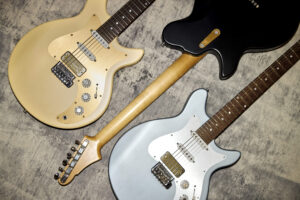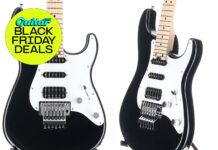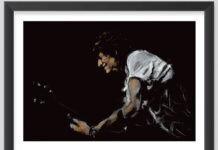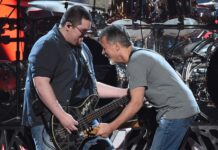
With the FullerTone, Eastman Guitars stands at the new frontier of quality affordable electrics
Eastman Guitars is one of the true upstart success stories of the last decade: its high-quality instruments have challenged outdated preconceptions about Chinese guitar-making, and earned fans among musicians big and small across the globe.
Now, the brand is disrupting the entry-level end of the market with the FullerTone – an instrument that takes everything the brand has learned over the last decade and applies it to its most affordable guitars yet. The results are spectacular.
The Eastman Guitars FullerTone on the Guitar.com Cover. Image: Joseph Bishop for Guitar.com
But Eastman’s CEO & founder Qian Ni never planned to be a guitar maker. A classically trained flautist, Qian started Eastman Strings in 1992, thinking he’d make quality violins, cellos and strings more affordably in China.
“I had no goals,” Qian admits. “I just wanted to see where it would go. I loved music and felt lucky to be able to potentially build something within an area that I enjoyed.”
“Eastman started the way all the old guitar companies did: the hard way, not the easy way” – Pepijn ‘t Hart
In the ensuing years, Eastman would expand rapidly, moving into making mandolins and archtop guitars before its first decade was up. Quite by accident, the company was charting a path that many iconic American electric guitar brands did almost a hundred years previously.
“Eastman really started the way all the old guitar companies started,” notes Eastman’s director of fretted instruments and product development, Pepijn ‘t Hart. “The hard way, not the easy way – with carved tops and dovetail neck joints.”
Image: Joseph Bishop for Guitar.com
The Hard Way
Doing it the hard way involved challenging the status quo. Traditionally, Chinese guitars were a means for US brands to produce their designs more affordably.
“Most people use China as cheap manufacturing, but China has a really high level of skill and craftsmanship,” asserts Qian. “A lot of people see China’s cheap labour, but cheap doesn’t mean low quality.”
When Eastman started out building violins, the aim wasn’t to reinvent how they were made – it was to do it using time-honoured methods in a place where training such skilled artisans was much lower. Given the similarities in their construction, it wasn’t long before Eastman started making archtop guitars, and it was through these early efforts that Qian crossed paths with American luthier Otto D’Ambrosio. Shortly after, Qian rang him “out of the blue”, D’Ambrosio remembers with a smile, and peppered him with an “overwhelming” number of questions about guitar building.
“We have to do some things differently and take the risks associated with that” – Qian Ni
It didn’t take long for D’Ambrosio to realise that the brand’s focus on doing things the hard way would reap benefits for guitar-making. As evidenced by seeing the brand’s Beijing workshop – which now produces all of Eastman’s electrics and archtops.
“The shop already had this knowledge base of working with their hands,” D’Ambrosio remembers. “That was always the part that fascinated me: seeing that level of skill there at that time when nobody else was doing it.”
Image: Joseph Bishop for Guitar.com
All In Our Hands
That grounding enabled Eastman to move into the big leagues of solidbody electric guitars in 2016. Their instruments clearly took inspiration from the classic designs, but with a level of craftsmanship, finesse and consistency that led this very publication to describe them as “giant killers”. But it wasn’t the overnight success it seemed to many.
“I’ve heard it many times over the years, ‘Oh, there’s a new workshop, and they’re going to be a real competitor for you’,” ‘t Hart explains. “Not to be cocky, but we know that’s not possible. Because we started in 1992 building violins, cellos and double basses by hand. You can’t just get 200 people and get them hand-building instruments to that level of expertise overnight – it’s impossible!”
“That’s what we do best: the hardworking culture of our craftspeople,” Qian agrees. “It’s about consistent craftsmanship. Our instruments are made by a team of specialists, all masters in their specific field of expertise. In a way it’s like what Stradivari did in Cremona – learning from the best.”
Image: Joseph Bishop for Guitar.com
The Shape Of Things To Come
The success of the first wave of Eastman solidbodies shook up the electric guitar world, but their next step – unique original designs – is one that has confounded many brands. But D’Ambrosio, now Eastman’s chief designer of fretted instruments, had something special cooking.
In 2019 Eastman launched the Romeo, a thinline semi-hollow that would be its first truly unique design. Fittingly, it was a guitar that was percolating in the background as an archtop project for D’Ambrosio before Qian intervened.
“I had not given Romeo the attention it deserved,” ‘t Hart explains. “[Qian] saw the prototype in the workshop and said, ‘Oh, this is the future of our electric guitars. This is the thinline that we should start building.’ And it shifted my view on Otto’s design, because suddenly I didn’t see it as an archtop. Now, it’s my most used Eastman guitar.”
Romeo got the ball rolling for a bold new phase of the Eastman electric guitars project: establishing a distinct visual style. Next came the Juliet, the brand’s first original solidbody, which won Eastman fans in a variety of artists, most notably James Dean Bradfield of Manic Street Preachers, who fittingly described it as “a design for life”. But these milestones were setting the stage for something even more significant.
Image: Joseph Bishop for Guitar.com
Bolt From The Blue
By the start of the 2020s, Eastman was an established electric guitar brand with a growing presence thanks to its original designs. But it still wasn’t doing everything its founder wanted it to do.
“Qian is a no nonsense guy,” ‘t Hart explains. “He said to me, ‘We’re still an acoustic company at heart’ – kind of disappointed! Because do you know how hard it is to break into the electric market?! We were so proud of our accomplishments. But then, I realised what he meant: you can only be an electric company if you can supply guitar players, with the FullerTone series, we have accomplished that.”
The challenges of making a great entry-level guitar were, for Eastman, worth facing. “We want to invest in making better instruments,” Qian explains. “In order to do so, we have to do some things differently and take the risks associated with that.”
“We have a blank slate to do whatever we feel is the right thing to do” – Pepijn ‘t Hart
So Eastman did the entirely unexpected: they started making guitars in the USA under D’Ambrosio’s supervision, and for the first time ever, they made a bolt-on – as opposed to the set-neck instruments the brand had been known for.
“We always said we could never do a bolt-on neck!” ‘t Hart laughs. “But Qian gives us so much trust and freedom… so I said to Otto, ‘Hey, what about a bolt-on? Is there anything we can do to improve Mr Fender’s brilliant design from the 50s? And Otto started doing what he does best.”
A bolt-on neck is a much simpler and thus more affordable instrument to produce than a set-neck, but one with its own eccentricities. “The Fender neck design, it’s been around for 70 years,” D’Ambrosio explains. “And while there are workarounds, the inherent flaws in terms of the screws loosening and the neck shifting are still there. So we just looked at it with a different kind of lens to figure out how we could really lock in the neck and body.”
The result was the FullerTone neck: a revolutionary new way of bonding guitar and neck together in a way that only requires a single bolt, but has the fit and stability of a set neck instrument. The resulting guitar, christened D’Ambrosio in honour of its designer, turned heads upon its launch in 2024. But it was just the start.
Image: Joseph Bishop for Guitar.com
The Fuller Picture
In 2025 Eastman launched a new range of guitars, named FullerTone after the neck that makes them possible, which at under £800 are also the most affordable electric guitars the brand has ever produced.
To get there, Eastman leaned on modern CNC production techniques, armed with the lessons learned in the US. “I don’t think the FullerTones would be as good as they are without the D’Ambrosio series,” ‘t Hart insists. “Otto made these guitars in his workshop to enable our shop to catch up. That’s the thing that Leo Fender did so brilliantly: he created this guitar that could be built in large quantities, without the quality ever dipping. That’s what we also needed to do with FullerTone.”
Not only do the FullerTone guitars feel like a culmination of 30 years of learning, creativity and expression for Eastman, they’re also a fitting tribute to the passion of the people who have collaborated to create it.
“We always said we could never do a bolt-on neck! But Qian gives us so much trust and freedom” – Pepijn ‘t Hart
“Otto and I, it’s like we both have Eastman tattooed across our hearts,” ‘t Hart says. “I could not imagine myself working for any other company, because we have a blank slate to do whatever we feel is the right thing to do.”
Qian Ni, whose colleagues credit with the trust necessary to experiment and innovate, remains self-deprecating. “We believe that we are building instruments that will help musicians to perform at a higher level, all the way down to the student,” he says, mission-based as ever. “You have to learn from the best. I won’t take any credit. We have been inspired by so many great companies, and if our work has done the same for others, we feel honoured to be a part of that history.”
For Pepijn ’t Hart, the only way for Eastman is up – but he’s still relishing being the upstart challenging the status quo while he can.
“I really try to cherish the place where we’re at now. Because there’s going to be a time when we are on top – then you have to stay there. This is the best part!”
Words: Josh Gardner
Photography: Joseph Bishop
The post With the FullerTone, Eastman Guitars stands at the new frontier of quality affordable electrics appeared first on Guitar.com | All Things Guitar.
Source: www.guitar-bass.net












